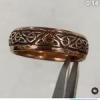That's good to know! I think of all this stuff as if they're Harley's-- there's always a loose screw somewhere!
And another thing, when these rotary's move, they move very abruptly. They start hard and stop hard. The chuck is pretty heavy its own self, and depending on how much weight is IN the chuck, the torque can move the whole rotary fixture if it's not clamped down (which is a bad habit of mine)...
And I found out another thing about these things the other day, that may (or not) help with rotary alignment issues-
Whatever size you tell your graphic to engrave, that's the exact size it will engrave in BOTH X and Y axis's, regardless of the part's actual diameter. This is much different than gantry rotating...
example: if you tell your gantry engraver you're engraving a 1" diameter part, but it's in fact 2" diameter, the Y height of what you're engraving will be twice as tall as it's supposed to be. Likewise, the reverse is true, telling the computer you're engraving a 2" part while engraving a 1" part , the Y height will be half what it should be. But in both (or any) case(s), the the X length will be correct.
This is because a gantry rotary moves in lines per inch the same as in 'flat' mode, and the computer compensates how far the line per inch spacing should be based on the circumference.
However, since a galvo don't do "lines per inch", there's no 'automatic' compensation for circumference. The machine engraves exactly what it 'sees'. So in order to engrave around a circumference, whatever you're engraving is done in horizontal "slices", and you have to chose how big each slice is. And you want the slices as small as possible, because engraving height stretches as it wraps down a radius.
The compensation that does exist is simply how far the rotary moves to engrave the next slice, and the machine needs to know the part's diameter. If you have it it slice in 3mm sections, it will engrave the 3mm slice, then move 3mm to do the next slice. The machine calculates how far 3mm is based on the diameter you've input into the software.
And therein lies the rub, because in my experience (so far), I've found the rotary seems to move farther than I've asked it to. The fix is to enter a larger diameter, which will shorten the move, closing the gap. And finally, to keep the seams less visible (or INvisible if possible), use and OPEN ENDED hatch fill with NO edge or contour engraving, this should help keep the engraving at the seams from overburning, resulting in less visible seams... hopefully!
When engraving using "textmark", the rotary works fantastic, because it moves the rotary automatically for each letter, no 'slice' guessing! The trick is to be sure the correct diameter of the part is entered. That's how I came to write this, as the other day I engraved a name around a 28mm diameter part. However, the entered diameter was the default 10mm-- the result was each letter was perfectly sized in both axis's, but the spacing between each letter was HUGE, like 3x the correct spacing, due to the diameter discrepancy...
All for now...




 - fiber lasers
- fiber lasers
 Reply With Quote
Reply With Quote


